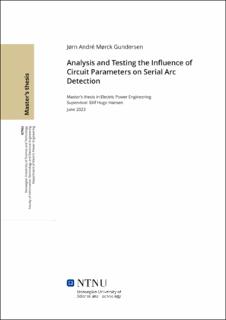| dc.description.abstract | Norsk brannstatistikk indikerer at elektriske branner er den ledende årsaken til boligbranner. Så lenge forskriftene for elektriske lavspenningsinstallasjoner følges vil beskyttelsen mot branner forårsaket av overbelastning og kortslutninger være overholdt. En betydelig del av de gjenværende brannene skyldes seriefeil, inkludert serielysbuer og resistiv oppvarming forårsaket av løse tilkoblinger. Disse feilene oppdages ikke av konvensjonelt beskyttelsesutstyr. For å håndtere disse feilene har nye vern kalt «arc fault protection devices», eller lysbuevern, kommet på markedet. Disse vernene bruker høyfrekvent støy med opprinnelse fra lysbuen til å oppdage feilen. Forskning utført tidligere har imidlertid indikert at den høyrefrekvente støyen kan skjules når ulike laster befinner seg i installasjonen.
Under denne oppgaven har påvirkningen av ulike laster og kretssammensetninger på den høyfrekvente støyen og konsekvense dette har på deteksjonsevenen til lysbuevern fra fire produsenter blitt undersøkt. Krav til bruk av disse nye enhetene er nært forestående i den førende europeiske standardiseringen, og før disse kravene innføres i den norske tilpasningen bør disse faktorene avklares. Testene utført i denne oppgaven ble derfor utført utover det som kreves av den europeiske testnormen IEC 62606.
Resultatene fra oppgaven indikerer at tegnene fra serielysbuer blir mindre målbare hvis lysbuestrømmen er betydelig lavere enn den parallelle laststrømmen i kretsen. I tillegg ble det funnet at tilkobling av kapasitive laster i parallell med den seriefeil belastede grenen førte til en dårligere deteksjonsevne for en av lysbuevernene som ble testet. Det samme lysbuevernet hadde også problemer med deteksjon av lysbuer når det var tilkoblet en elektronisk last i form av en likerettende strømforsyning i kretsen.
Videre ble det testet hvor gode lysbuevernene var til å oppdage ulike lysbuer og hva den nedre strømgrensen for utkobling var. De forskjellige lysbuene som ble testet var kontaktlysbuer, gjennomslag i luft og lysbuer på forkullet isolasjon i kabler. Resultatene viste pålitelig deteksjon av kontaktlysbuer og lysbuer på forkullet isolasjon, men variabel deteksjon av elektriske gjennomslag i luft. Resultatene viste også at enhetene som ble testet oppfylte kravet i teststandarden IEC 62606 til laveste deteksjonsgrense på 2.5A, men terskelen til de forskjellige leverandørene varierte fra 1.0A til 2.5A
Ved å belyse påvirkningen av kretsparametere, belastninger og ulike lysbuefeil på ytelsen til lysbuevernene kan denne forskningen bidra til forståelsen av lysbueoppdagelse og hjelpe i implementeringen av disse vernene i de norske tilpasningene av lavspenningsinstallasjon standarden. | |
| dc.description.abstract | Fire statistics indicate that electric fires are the leading cause of residential fires in Norway. As long as low voltage regulations are followed, protection should be provided against electrical fires caused by overloads and short circuits. A significant portion of the remaining fires are caused by series faults, including series arcing and resistance heating caused by loose connections, which are not detected with conventional protection equipment. To address this issue, a new type of protection device, called arc fault detection devices, has emerged in the market. These devices detect arcs by measuring the high frequency noise generated during an arc. However, previous research and theses have indicated that the signs used for arc detection can be obscured by different loads in the circuit.
During this thesis the influence of differen load and circuit parameters on the high frequency noise and the consequenses this have on the detection ability of arc detection devices from four devices from different manufacturers. The inclusion of these devices in the European electrical regulation is imminent, and before these devices are implemented in the Norwegian adaption these factors should be clarified. Due to this, the tests conducted in this thesis went beyond what is required by IEC 62606.
The results of the tests indicate that the signatures of series arcs are obscured if the arcing current is significantly smaller than the parallel load current in the circuit. Additionally, the inclusion of capacitance in parallel with the series arc fault was found to influence the detection ability of one of the devices. The same device also was troubled by having an electronic load, a switch-mode power supply, connected in parallel.
Furthermore the detection of different arc faults and the lower limits of disconnection was tested. The tested arc faults where contact arcing, electrical breakdown in air and arcing on char in a cable. The results demonstrated reliable detection of arcing on char and contact arcing, while detection of electrical breakdown in air exhibited more variability. It was also shown that all the tested devices met the requirement set by the test standard IEC 62606, although the specific threshold level varied across devices, ranging from 1.0A to 2.5A.
By shedding light on the influence of circuit parameters, loads, and various arc faults on the performance of arc fault detection devices, this research can contribute to the understanding of arc fault detection and the implementation of these devices in electrical installations. Further the results raise the question whether some of the devices sold in the market today may be too tuned for passing the requirements of the test standard, and if the test required by the test standard are adequate to verify the detection capabilities of the devices. | |
